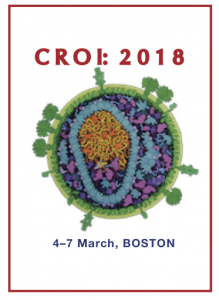M184V mutation associated with increased risk of viral blip but not viral failure with 3TC-based dual therapy
16 April 2018. Related: Conference reports, Treatment strategies, Drug resistance, CROI 25 (Retrovirus) 2018.
 Satyajit Das, HIV i-Base
Satyajit Das, HIV i-Base
Although dual therapy is not recommended in treatment guidelines, this strategy is sometimes used when the option to use a dual NRTI backbone is contraindicated. The impact of the 3TC-associated M184V mutation on viral outcome is unclear, given the resulting impact on reducing viral fitness.
A retrospective analysis from the Italian Antiviral Resistance Cohort Analysis (ARCA) database looked at risk of viral rebound in people who switched to 3TC-based dual ART when viral load was <50 copies/mL on their current ART.
The analysis included 436 participants, of which 87 had the M184V mutation in a previous resistance test. Patients were followed from the time of switching to the time of virological failure (VF), defined as two consecutive viral load results >50 copies/mL or single result > 200 copies/mL. or discontinuation. The primary aim was to find out the time to virological failure with or without M18V mutation. The secondary aim was to find out the time to virological blips (VB), defined as a single viral result of 50 to 199 copies/mL, and predictors of virological failure and blips between the two groups.
Factors with strongest association of having M184V included older age, longer duration of HIV, longer time to ART and duration of viral suppression, lower CD4 at nadir, HCV coinfection and reduced genotypic sensitivity to the second ART component (all p <0.001).
During 693 person-years of follow-up (PYFU) the incidence of VF was 5.1/100 vs 3.1 per 100 PYFU in M184V positive vs negative groups respectively. Time to VF did not differ between groups and the only predictors of VF in multivariate analysis were higher (p=0.035) zenith virological value and HBsAg positivity (p=0.005).
In participants with previous viral suppression for more six years, the three year probability of remaining free from VF was 82% vs 92% in the M184V positive vs negative groups respectively (NS, p=0.080). The probability of remaining free of VB was 69% vs 91%, respectively, (p<0.001).
M184V was not associated with a higher risk of VF when 3TC was used with a boosted PI or dolutegravir, but there was a higher probability of VB. In participants with M184V, a shorter time of viral suppression appeared to increase the risk of VF and of VB. There were no cases of viral failure in 21 participants with the M184V mutation using doluteravir plus 3TC, after a median follow-up of 10 months.
The study concluded that prior selection of M184V did not seem to play a significant role on virological efficacy with 3TC+boosted PI or dolutegravir with 3TC as a switch regimen.
Nonetheless, a virological signal was seen for previous M184V and higher probability of viral blips and shorter time of prior viral suppression appearing to increase the risk of virological failure and of virological blips in this group.
comment
Limitations for this study include retrospective observational design, limited statistical power, no data about adherence, and significant different baseline characteristics of the two groups.
Reference
Gagliardini R et al. Impact of previous M184V on virological outcome of switch to 3tc-based dual therapies. 5th Conference on Retroviruses and Opportunistic Infections (CROI 2018), 4–7 March 2018, Boston. Poster abstract 498.
http://www.croiconference.org/sessions/impact-previous-m184v-virological-outcome-switch-3tc-based-dual-therapies (abstract and poster)

